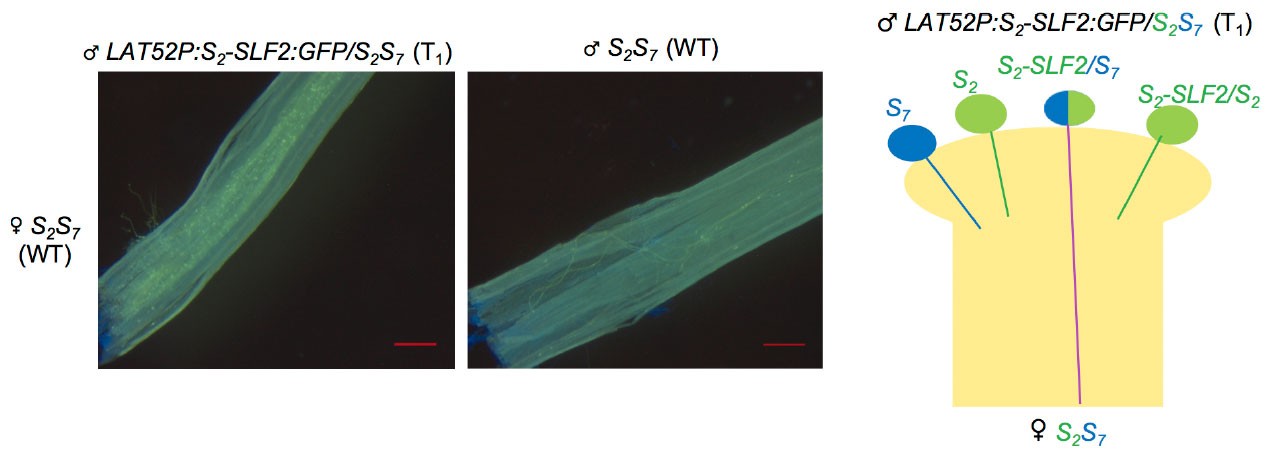博文
Plant Cell:矮牵牛SLF蛋白作用于自交不亲和中的花粉功能
||
S-Locus F-Box Proteins Are Solely Responsible for Pollen Function in S-RNase-Based Self-Incompatibility of Petunia
First author: Linhan Sun; Affiliations: The Pennsylvania State University (宾夕法尼亚州立大学): Pennsylvania, USA
Corresponding author: Teh-hui Kao
Self-incompatibility (SI; 自交不亲和性) in Petunia (矮牵牛) is regulated by a polymorphic S-locus. For each S-haplotype, the S-locus contains a pistil-specific (雌蕊) S-RNase gene and multiple pollen-specific S-locus F-box (SLF) genes. Both gain-of-function and loss-of-function experiments have shown that S-RNase alone regulates pistil specificity in SI. Gain-of-function experiments on SLF genes suggest that the entire suite of encoded proteins constitute the pollen specificity determinant. However, clear-cut loss-of-function experiments must be performed to determine if SLF proteins are essential for SI of pollen. Here, we used CRISPR/Cas9 to generate two frame-shift indel alleles of S2-SLF1 (SLF1 of S2-haplotype) in S2S3 plants of P. inflata and examined the effect on the SI behavior of S2 pollen. In the absence of a functional S2-SLF1, S2 pollen was either rejected by, or remained compatible (亲和) with, pistils carrying one of eight normally compatible S-haplotypes. All results are consistent with interaction relationships between the 17 SLF proteins of S2-haplotype and these eight S-RNases that had been determined by gain-of-function experiments performed previously or in this work. Our loss-of-function results provide definitive evidence that SLF proteins are solely responsible for SI of pollen, and they reveal their diverse and complex interaction relationships with S-RNases to maintain SI while ensuring cross-compatibility (杂交亲和性).
矮牵牛的自交不亲和性受到多态性位点S-locus所调控。对于每一个S单倍型,S-locus包含了雌蕊特异性S-RNase基因和多个花粉特异性S位点F-box基因SLF。S-RNase基因的功能获得和功能缺失突变体显示其在自交不亲和中调控雌蕊特异性。SLF基因的功能获得突变体显示所有的SLF蛋白均能决定花粉特异性。然而,还未有试验构建出SLF基因的功能完全缺失突变体来验证SLF蛋白是否作用于自交不亲和中花粉特异性。本文基于矮牵牛S2S3植株,利用CRISPR/Cas9技术构建了两个S2单倍型SLF1的移码突变体,继而评测S2花粉对于自交不亲和的影响。在缺失了功能性的S2-SLF1蛋白后,S2花粉要么被带有8个正常亲和S单倍型的雌蕊所拒绝,亦或是还能够亲和。所有的结果与S2单倍型的17个SLF蛋白和8个已验证过功能的S-RNases相互作用保持一致。本文的功能缺失突变体结果表明SLF蛋白仅仅作用于花粉的自交不亲和性,并且还揭示了SLF与S-RNases复杂多样的互作关系以维持自交不亲和性,进而保证杂交亲和性。
通讯:Teh-hui Kao(http://bmb.psu.edu/directory/txk3)
研究方向:植物生殖过程中自我/非自我识别的生化和分子基础。
doi: https://doi.org/10.1105/tpc.18.00615
Journal: Plant Cell
First Published: 29 September, 2018
(P.S. 原文下载:链接:https://pan.baidu.com/s/1qFiSsqwlF_7JjmGMbedfhQ 密码:dmu6)
https://blog.sciencenet.cn/blog-3158122-1143893.html
上一篇:iScience:猕猴桃基因组再分析
下一篇:Nature Communications:lncRNA SVALKA调控拟南芥的低温适应
全部作者的其他最新博文
- • Plant Physiology:CsMADS3促进柑果中的叶绿素降解和类胡萝卜素合成(华中农业大学)
- • Molecular Plant:LBD11-ROS反馈调节作用于拟南芥的维管形成层增殖和次生生长(浦项科技大学)
- • Science Advances:根结线虫通过调控植物的CLE3-CLV1模块,促进侵染进程(日本熊本大学)
- • Nature Communications:油菜素内酯参与植物营养生长期转变的分子机制解析(浙江农林大学)
- • Current Biology:光合作用产生的蔗糖驱动侧根“生物钟”(德国弗莱堡大学)
- • PNAS:花同源异型基因在叶中被抑制、花中被激活的分子机制(南卡罗来纳大学)


